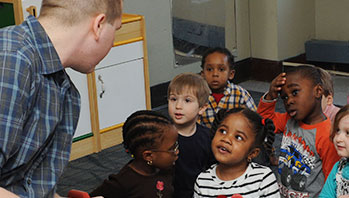- assortment of root, stem, fruit, seed vegetables, and herbs (If possible, include some of those featured in Chicks and Salsa and Eating the Alphabet—tomato, grapes, cabbage, cucumber, beans, limes, carrot, cauliflower, etc.)
- part
- plant
MA Standards:
Speaking and Listening/SL.PK.MA.1: Participate in collaborative conversations with diverse partners during daily routines and play.
Language/L.PK.MA.6: Use words and phrases acquired through conversations, listening to books read aloud, activities, and play.
Head Start Outcomes:
Language Development/Receptive Language: Attends to language during conversations, songs, stories, or other learning experiences.
Language Development/Expressive Language: Uses language to express ideas and needs.
Logic and Reasoning/Reasoning and Problem Solving: Classifies, compares, and contrasts objects, events, and experiences.
Science Knowledge/Scientific Skills and Method: Observes and discusses common properties, differences, and comparisons among objects.
PreK Learning Guidelines:
English Language Arts/Language 2: Participate actively in discussions, listen to the ideas of others, and ask and answer relevant questions.
Talk Together: Parts We Eat

© Commonwealth of Massachusetts, Department of Early Education and Care (Jennifer Waddell photographer). All rights reserved.
STEM Key Concepts: Some plants start from seeds; Plants grow in many places; Many foods that animals, including humans, eat come from plants; We eat certain leaves, roots, fruits, and seeds
ELA Focus Skills: Listening and Speaking, Vocabulary
Educator Prep: On chart paper, draw simple outlines of a tree, a bush, and a vine. Make a line to indicate above ground and below ground.
Display the assortment of vegetables, fruits, and herbs for children. Then draw attention to the chart paper and describe each illustration (vine, tree, bush, above ground, below ground). Explain how animals—including humans—eat plants that grow in many different places. Point to a drawing, hold up an appropriate plant that grows there and describe it. For example, say,
- Apples grow on trees. Do you know any other plants we eat that grow on trees? (nuts, oranges, olives)
- Cucumbers grow on vines. Do you know any other plants we eat that grow on vines? (peas, grapes, pumpkins)
- Carrots grow in the ground. Do you know what part of the plant a carrot is? (root) Do you know any other plants we eat that grow in the ground?
- Cauliflower grows above the ground. Do you know what part of the plant the cauliflower is? (flower) Do you know any other plants whose flower we eat? (broccoli)
Ask children if they have ever seen or eaten any of these plants. If so, ask them to describe how it tasted, felt, and smelled. Explain that when you describe food using all your senses it helps to give other people a better idea of what the food is like.
